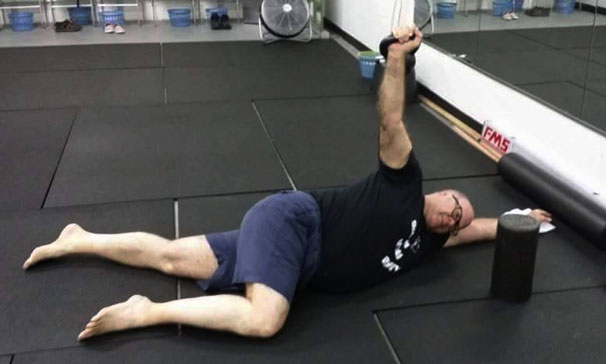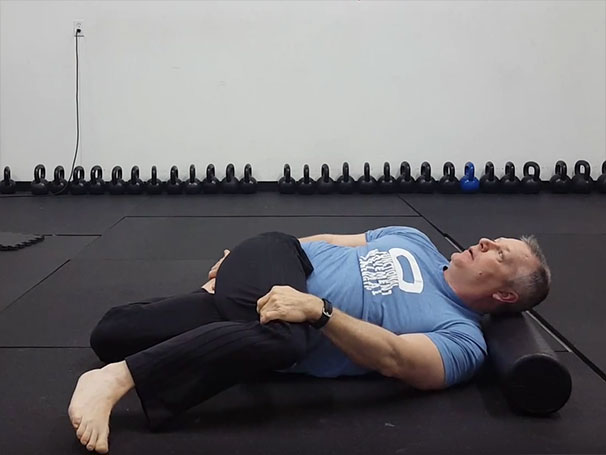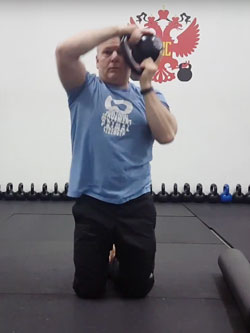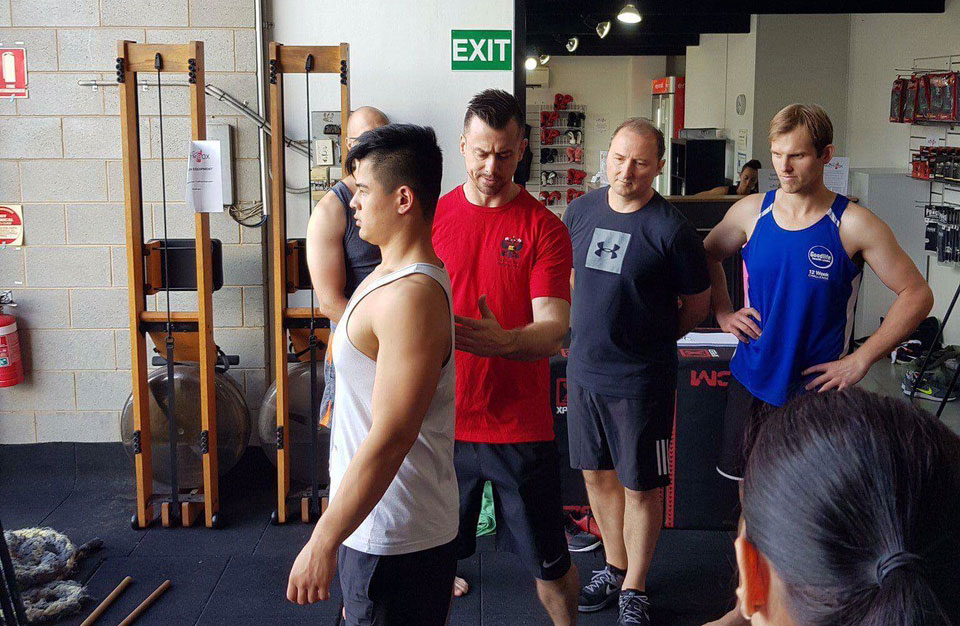
The kettlebell community has taught the concept of shoulder packing to stabilize the shoulder for a very long time. I have seen it cued, taught, and discussed for about 14 years! As a Master RKC, I see this concept taught worldwide. But for a long time I’ve wondered if everyone really understands the cues.
The premise of “shoulder packing” is to prevent the shoulders from rising towards the ear at the beginning and end of the press—and to keep the shoulder from excessive elevation during the lock out and overhead lifts. The use of the cue “pack the shoulder” or “engage the lats as you initiate the press” is a simplification for the average client. It cues them to avoid excessively using the upper traps and levators to initiate the press. Instead, they should keep the shoulder stable by engaging all four shoulder rotators, the lower traps, and the subclavius (which helps to seat the clavicle in the sternoclavicular joint).
Most clients are desk athletes that come into our gyms with protracted shoulders and a forward head position. Many of them are also upper trap dominant and have poor T-spine mobility. The easiest cue to help someone keep their shoulders from rising to their ears, and thereby risking shoulder impingement and injury has often been: “pack your shoulders by engaging your lats”. But, a better cue might be to engage your entire mid-back along with the shoulder muscles. And it’s also important to remember that over cueing or using unnecessary cues can lead to other shoulder movement problems and issues.
Let’s explore how the lat attaches to the body from a textbook anatomy perspective. Then from a functional anatomy perspective, we can see what it actually does.
| Attachment: | Function: | Requirements for a great press: |
| Thoracolumbar fascia: 4-8 vertebrae or illium | Humeral extension /adduction | Humerus flexion/abduction |
| Ribs | Internal rotation | Ext rotation for healthy position |
| Scapula (40% of population ) | Weak horizontal abduction | Upward rotation and slight posterior tilt of scapula |
| Intertubercular groove of humerus | Lumber extension | Stable core |
| (can differ for people) | Lateral flexion | Rib cage in neutral alignment |
| Involved in core, neck and respiration |
In the last column above, I’ve described what happens when we press overhead or hold a weight overhead. Activating the lat strongly does the exact opposite of what we want to do when we press or go overhead. When we use the cue “pack the shoulders with the lat”, we can cause scapula depression because of all of its attachment points—which will force the downward rotation of the scapula. This is in direct opposition to the upward rotation of scapula required in an overhead lift. If we “pack the shoulder with the lat” we close the space in the AC joint, and since the lat is also responsible for internal rotation, we are more likely to get some cuff impingement.
Upward rotation of the scapula is perfectly normal and healthy as long as the person has good T-spine mobility and sufficient external rotation of the humerus. In fact, many people need to focus on external rotation when pressing overhead so that they naturally and unconsciously fire the lats, rotator cuff, rhomboids and lower and middle traps in a perfectly synchronized and sequenced way.
Remember, head forward position, poor motor control with the external rotators, and poor T-spine mobility are often the causes of shoulder impingement. When someone performs a good overhead press, they should also have a stable core and neutral rib cage, with no rib flare.
An important component of healthy overhead lifting is unconsciously activating the pesky lower traps in your mid back. While they have no direct control of the humerus, they are an integral part of upward scapular rotation. They are also responsible for some posterior tilt and retraction of the scapula required for correct overhead mechanics.
The activation of the lower trap along with the muscles of the rotator cuff, serratus anterior, rhomboids and lats in the correct sequencing actually helps clear the space in the shoulder for the humerus to move. When we see someone’s shoulder come back to its optimal position, we usually see the upper back contract very subtly. Perhaps the correct strategy for optimal shoulder position is firing the lower traps-not the lats.
The shoulder “packing” cue needs to be used very carefully—much like the cues “pull the belly button in” for core activation (when the core unconsciously fires in a perfectly healthy person), pushing the knees out for correct knee and toe alignment (even when alignment is fine, hence sending someone into varus—the opposite of “valgus” collapse) or the “big chest” cue that can cause undesirable rib flare in some lifts. Trainers should not cue clients on autopilot without observing the actual situation.
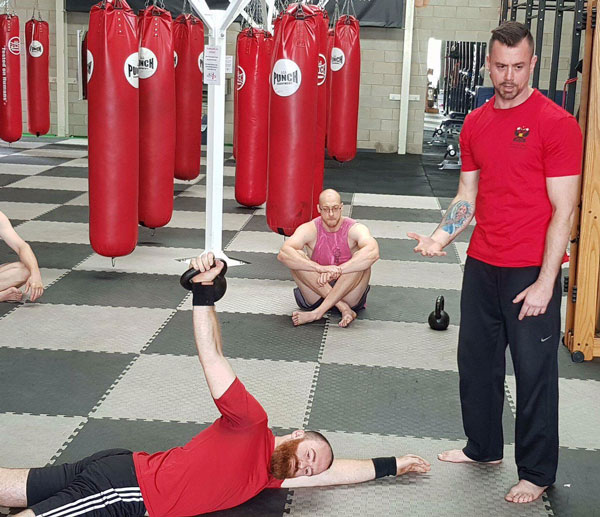
Trainers using cues unnecessarily, misunderstanding the nuance and subtleties of the cues, or not understanding the logic behind cues can cause real problems. Better education and understanding of why specific cues are given needs to happen so we can all abide by the first rule of training others: do no harm. Perhaps the cue should be to “activate” the upper back to keep the shoulder in a natural position without overly sucking it down or packing it down. Or maybe some clients would better respond to the cue: “relax the shoulder away from the ear”. Regardless the words chosen, we should only use cues when necessary, not all the time.
Many haphazardly overused cues in the fitness industry also expose a poor understanding of functional anatomy and nuance. Without that understanding, we could be creating some long term negative effects with incorrect cuing. When the shoulder “packs” naturally, it’s a very subtle movement. The human body is amazing, and sometimes trying to outsmart it to make it better can have the opposite result.
***
Matt Beecroft is a Master RKC, PCC Team Leader and CK-FMS instructor with over 17 years as a personal trainer. He is a national fitness presenter with Thump Boxing, an Expert Level 2 Krav Maga instructor with KMG, Muay Thai coach and movement specialist in systems such as CST, Ground Force Method and Animal Flow. He writes for various publications including Breaking Muscle and Blitz Magazine and can be contacted by his Facebook page https://www.facebook.com/MeetLifeHeadOn/ or his website https://www.realitysdc.com.au/

